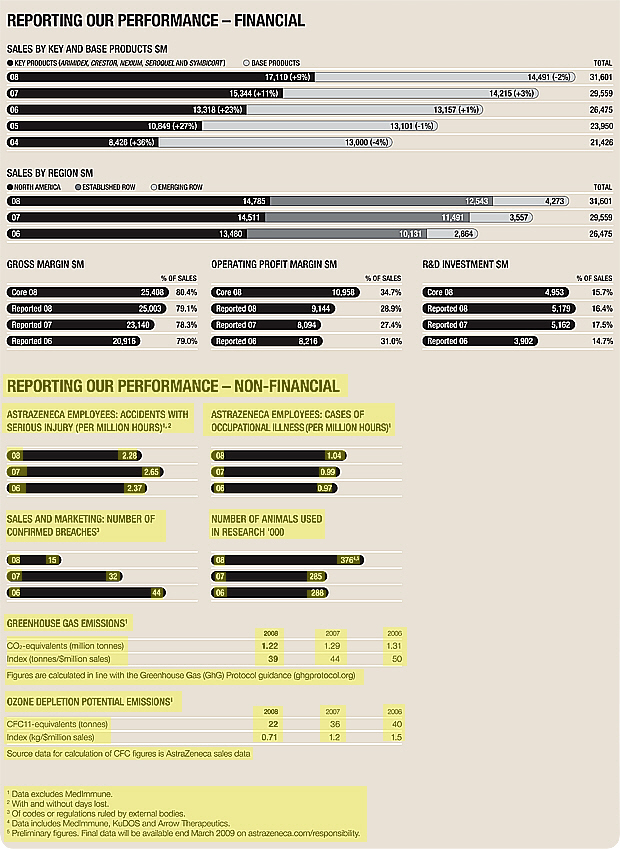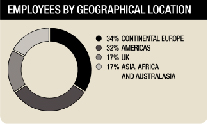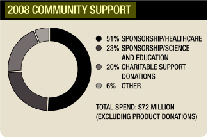Our commitment to patient safety includes ensuring the security of our medicines throughout their manufacture and supply. We continuously monitor our business environment to identify any new or emerging product security risks and work to ensure that these are managed quickly and effectively. In addition to our internal processes, we also work with regulatory authorities, government agencies, trade associations and law enforcement agencies to combat the growing threat of counterfeiting. Further details of the ways in which we manage the risk of counterfeiting can be found in the Principal Risks and Uncertainties section from page 76.
HOW WE PRICE OUR MEDICINES
Despite significant advances in healthcare in recent decades, many diseases are still under-diagnosed or not well treated, or there is not yet an effective therapy. Continued innovation is required to address these unmet medical needs. At the same time, the growing demand for healthcare, driven by people living longer, increasing populations and the emergence of new economies, means ever greater pressure on the payers’ budgets.
At AstraZeneca, our challenge is to balance the associated downward pressure on the price of medicines with the cost of the continued innovation that brings benefit for patients and society.
When setting the price of a medicine, we take into consideration its full value to patients, to those who pay for healthcare and to society in general. Our pricing also takes account of the fact that, as a publicly owned company, we have a duty to ensure that we continue to deliver an appropriate return on investment for our shareholders. We balance many different factors, including ensuring appropriate patient access, in our global pricing policy, which provides the framework for optimising the profitability of our products in a sustainable way.
We continually review our range of medicines (both those on the market and in the pipeline) to identify any that may be regarded as particularly critical to meeting healthcare needs – either because they treat diseases that are (or are becoming) prevalent in developing countries, or because they are potentially a leading or unique therapy addressing an unmet need and offering significant patient benefit in treating a serious or life-threatening condition. In such cases, we aim to provide patient access to these medicines through expanded patient access programmes. We also support the concept of differential
pricing in this context, provided that safeguards are in place to ensure that differentially priced products are not diverted from patients who need them, to be sold and used in more affluent markets.
BRINGING ECONOMIC AS WELL
AS THERAPEUTIC BENEFIT
Our medicines play an important role in treating serious disease and in doing so they bring economic as well as therapeutic benefits. Effective treatments can help to save healthcare costs by reducing the need for more expensive care, such as hospital stays or surgery. They also contribute to increased productivity by reducing or preventing the incidence of diseases that keep people away from work.
R&D STRATEGY
Our R&D strategy is geared to maintaining a flow of new products that will deliver sustained business growth in the short, medium and long-term.
In the short-term, we have continued to build on the good growth achieved in 2007. Our overall portfolio volume has grown by 5% and our in-phase distribution of the projects has improved. Phase III volumes have remained constant and our Phase II portfolio has grown by over 50% (20 to 31) during 2008.
Notable successes in the life-cycle management (LCM) of our key marketed products during the year included eight significant submissions and three approvals in the US and/or the EU, which are described in the Therapy Area Review commencing on page 53.
In the medium-term, we will continue to drive our pre-clinical and clinical Phase I and II projects towards proof of concept as rapidly as possible. In line with our ongoing externalisation strategy, we continue to look beyond our own laboratories, and actively seek alliances and acquisitions with external partners to gain access to leading drug projects or technology platforms.
The progress we are making in our drive to increase productivity is reflected in the delivery of projects from discovery and the growth of our early development portfolio. We have introduced a more rigorous and consistent measure for the number of compounds reaching development and now record additions to the pipeline from the first pre-clinical study conducted for
regulatory approval purposes (First Good Laboratory Practice (FGLP)) instead of when a candidate drug is simply nominated for development. During 2008, 32 FGLPs were selected for development (compared with 36 in 2007).
Further details are set out in the Development Pipeline table on pages 22 to 24.
DISEASE AREA STRATEGIES
Our disease area strategies are established using a regular review process that centres on the evaluation of research opportunities against a set of consistent criteria, including unmet medical need, commercial and scientific opportunity, competitive position and alignment with our capabilities. Our R&D Executive Committee (further details of which are set out on page 21) uses the reviews to determine the levels of investment we will make in different disease areas. The process also enables us to deploy our resources in the best way to meet our commercial and scientific objectives.
Our New Opportunities Team, operating from pre-clinical through development, generates more value from disease mechanisms and compounds through both internal efforts and external alliances with the aim to transform them into profitable, innovative therapies. In addition, the New Opportunities Team will consider a broad range of pre-clinical to late stage development opportunities. This includes identification of compounds that help address side effects and complications in disease areas we have prioritised, and of opportunities that enable rapid entry into breaking new disease areas via strategic alliances, in order to provide additional assets for our pipeline and the delivery of profitable growth.
OUR RESOURCES
AstraZeneca’s research effort spans a range of different disciplines and locations, but our scientific community shares a common goal: to deliver new and innovative medicines to patients as quickly, efficiently and safely as possible. They work together across national boundaries and sites to exchange ideas, promote best practice and maximise the scientific potential offered by our size and global reach.
We have a global R&D organisation, with around 12,000 people at 17 principal centres in eight countries. Our main small molecule facilities are in the UK (Alderley Park, Macclesfield and Charnwood); Sweden (Lund, MöIndal and Södertälje); and the US (Boston, Massachusetts and Wilmington, Delaware). Other sites which have a focus on discovery
ASTRAZENECA ANNUAL REPORT AND FORM 20-F INFORMATION 2008


